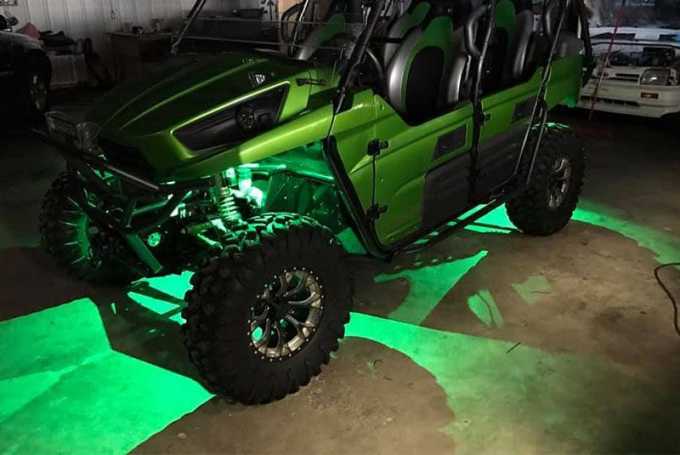Whether you have a Jeep that gets muddy, a side-by-side that thinks it’s a part-time submarine, or a boat that’s always getting swamped, Rockford Fosgate’s M5-1500X5 powersports amplifier can be the heart of an impressive audio system upgrade. This five-channel amplifier can deliver the power your speakers need to reproduce audio with amazing clarity while driving a subwoofer or two to give your music impact and warmth – all from a single chassis. If you agree that this sounds like the perfect upgrade for your mobile sound system, read on to learn more about this fantastic amplifier.
Rockford Fosgate M5-1500X5 Specifications
The M5-1500X5 amplifier is rated to produce 100 watts per channel from the four main channels and an impressive 600 watts from the subwoofer channel. The front channels can drive 2- or 4-ohm loads while the subwoofer channel is optimized to produce that power into a 2- or 1-ohm load. The sub channel makes 400 watts into a 4-ohm load. If you have an application where you need huge power for a set of tower speakers, the front and rear channel pairs can be bridged to drive a pair of 4-ohm loads with 200 watts to each speaker. Of course, all of the specifications for the amp are compliant with the CTA-2006 standard, so you know you can trust the ratings. Based on our experience with the M5-1000X1, the numbers are likely conservative.
The front, rear and subwoofer channels each have a dedicated sensitivity control, Punch EQ control and a crossover that’s adjustable between 50 and 250 Hz. The Punch EQ allows up to 18 dB of boost at 45 hertz on the subwoofer channel and combines that bass attenuation with treble boost centered at 12.5 kHz on the front channels. The crossover on the front channels can be run in high- or low-pass modes or defeated completely. The adjustable subwoofer channel crossover is always on and limits high-frequency information. Your installer can connect an RCA cable directly to the RCA input for the sub channel, or set the Sub Input Switch off and let the amp combine the signals from the front and rear channel inputs. The subwoofer channel has a fixed -12 dB/octave infrasonic filter that’s set to 30 hertz to protect your subwoofers and optimize their output. There’s also a two- or four-channel switch on the end of the amp by the input connections. Setting this to two-channel mode copies the signal from the front channel inputs to the rear channels.
Rockford Fosgate includes their C.L.E.A.N. input and output monitoring circuit, making it easy for your installer to maximize the signals going into the amp and set the output level controls to deliver maximum performance. They’ve also included a PRESET switch for level and crossover settings for use with their vehicle-specific Motorsports stage kits. These settings can be invoked by activating the PRESET switch on each channel.

The amplifier makes use of several technologies found on other premium Rockford Fosgate amplifiers. The NOMAD protection circuitry guards against short circuits on the speaker connections. The Class-AD and Class-BD designs help to ensure good efficiency to maximize the capabilities of the magneto or alternator and battery on your boat or side-by-side. Likewise, the lightly regulated P.O.W.E.R. technology for the power supply design allows the amplifier to maximize output power when it’s fed with more voltage. Finally, the Maximum Efficiency Heat Sink Application (MEHSA) heat sink design helps to ensure that the amp keeps running when pushed hard by spreading thermal energy throughout the chassis.

Five-Channel Powersports Amplifier Layout
The M5-1500X5 is based on a 4.25- by 1.7-inch extruded aluminum chassis that’s 12.3 inches long, including the cast aluminum end-caps. The connections for input signals, along with speaker and power output, are made via pigtail harnesses that attach to each end of the amplifier. The harnesses are held in place with screws and feature gaskets to ensure that everything is watertight.
The controls are on the top of the amp on the left side and are protected by a removable cover once set. As you’d expect, the cover includes a rubber gasket to keep water, dust and debris out of the amp. The combination of these waterproofing features gives the amp an IPX6 water and dust intrusion rating. Rockford Fosgate calls this their Element Ready design, and it includes testing for prolonged UV exposure as well as corrosion resistance.

Upgrade Your Adventure with Rockford Fosgate
Your local authorized Rockford Fosgate dealer would be happy to design an audio system upgrade for your boat, side-by-side, off-roader or Jeep using the M5-1500X5. You can find a dealer near you by using the Dealer Locator on their website. To keep up with the latest new product release, cool events and amazing vehicle features from Rockford Fosgate, be sure to follow them on Facebook, Instagram and their YouTube channel.
This article is written and produced by the team at www.BestCarAudio.com. Reproduction or use of any kind is prohibited without the express written permission of 1sixty8 media.






























